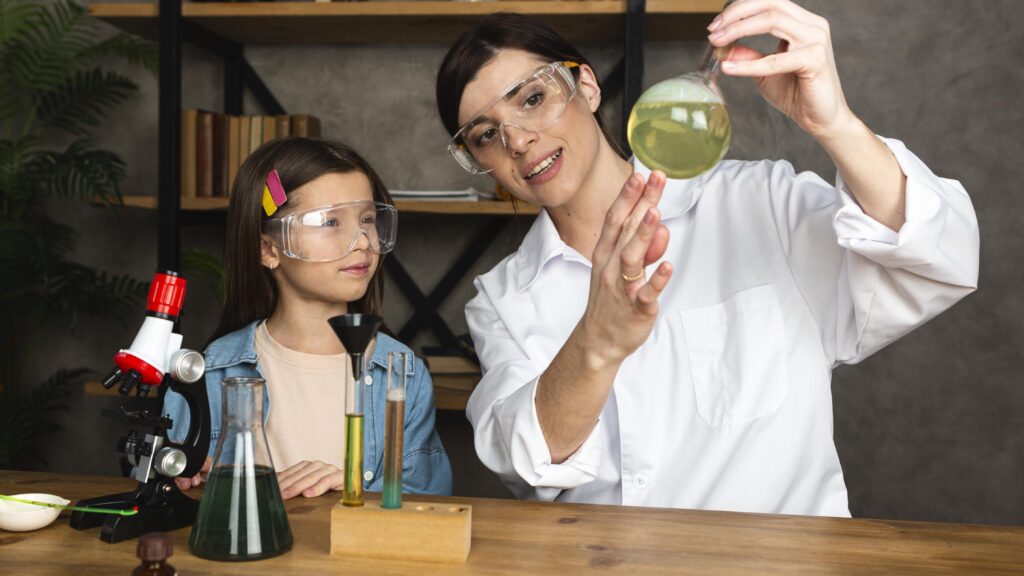Children love experiments and practicality. However, they’re also fascinated by the theoretical side of science. It’s vital to foster this enthusiasm early on because a child’s interest in science is formed before they enter primary school. While we ensure that our school teachers fulfill their responsibility to cultivate their interest in science, parents can help by setting the stage for their child’s love for the subject.
Most children are fascinated by how things work. Parents can inspire them to learn the scientific principles behind everyday technology by showing them famous inventors and teaching them fun science lessons. They can have their kids build projects to make science fun that demonstrate how physics principles work with household items such as popsicle sticks, empty boxes, etc.
If you are wondering how to make science interesting for students, reach out to our faculties, as they will give you an introduction to our teaching methods and how we cultivate a productive environment with interesting science lessons for kids. By offering them an engaging classroom and interesting science lessons, we allow them to ask questions and explore science in the most fun-filled way.
Being one of the top schools in Vadodara, we at Nalanda International School believe students should be allowed to explore and experiment. It’s one of the key ways to make science fun for students. We also make use of pictures or videos to illustrate concepts. Moreover, images can also be used to inspire writing prompts in the classroom. This way, we ensure every student gets a chance to use their natural curiosity while learning about science.
Some practical ways to offer exciting & fun science lessons for kids in schools:
1. Exploring Nature
If you’re looking for ways to make science fun for kids in school, you may have heard about the concept of exploring nature. By using the five senses, kids will learn about their natural surroundings and enjoy the process of interpreting them. We at Nalanda International School arrange several wild trips for kids. They can visit a nature preserve or collect samples of the soil they find there and can even create a poster depicting their favorite outdoor activity.
There are many ways to make science fun for kids by creating them to explore nature. One of the most common ways to learn about the planet is through nature. There are many parks that offer paved walking paths through nature, making it easier for kids to explore nature. They can also observe plants, trees, and wildlife while exploring the park’s ecosystem. We also arrange a fun-filled visit to farms, where our students can learn about local plants and animals.
2. Animated & Multimedia Learning
A popular approach to making kids’ science lessons more appealing involves animation and multimedia content. Our creative approach to learning has helped us become one of the best schools in Vadodara for ambitious students. We have an engaging classroom filled with mind-blowing and fun science lessons for kids to learn & grow. This is because multimedia tools allow them to speak like scientists, which is crucial in facilitating their understanding of the subject.
Using different mediums such as video, audio and animation can ensure that kids are more likely to pay attention to the lessons. Animated videos can also help children focus on the text because children respond well to emotional aspects. Children are more likely to remember and comprehend the lessons better if audio descriptions accompany them. Animated and multimedia content can also be used to illustrate complicated concepts. Students learn by using the appropriate language and developing the ability to think like a scientist.
3. Kitchen Gardening
There are countless benefits of using kitchen gardening to teach children about science. It’s a creative way to make science more interesting for kids. They can observe plants growing and plan experiments around their growth. They can also create seed tracking sheets and keep plant growth over time. These printable sheets can be used in science journals or a garden notebook. The active involvement of children in growing and harvesting food can help them recognize their food preferences and may encourage them to try new foods.
We understand the benefits of kitchen gardening for kids and ensure they learn valuable things from gardening. That is why we run a full-fledged kitchen garden in the school where we grow vegetables like Okra, Carrots, Chili, Brinjal, French Beans, Tomatoes, Calabash and so on. Children routinely plant seeds, nurture the vegetables, reap them when they are ready and take some samples home to finally bring them to their dining tables at home, in the process understanding the entire food cycle. Hence children learn about responsibility, consequences, and the satisfaction of a job well done. In addition, the environment around the garden is safe and conducive to growing a healthy garden. Our gardening experts help students explore the best kitchen gardening world on our school premises.
4. Practicing Science
Students feel like real scientists working in science labs, and when students interact with different materials, they learn to ask “why” questions. Science is all about the ‘why’ questions! Students learn how to experiment, collect, and use data to make decisions. If you are wondering how to make science interesting for students, contact our teachers to learn how we make science fun for kids. Our well-resourced science lab and engaging classroom ensure our students learn in the best environment. They are the primary means by which students make observations and develop theories.
We believe that the right resources are well worth the cost. Our students often do science fair projects as a way to improve other skills as well. Besides learning the scientific method, they are also forced to think critically about the results of their experiments. Science fair projects provide a sense of accomplishment and self-validation and are an excellent way to increase confidence and maturity. If done well, a science fair project will teach kids a lot about science, which can be exciting and lifelong!
5. Field Trips
There are many ways to make science fun for kids, and one great way is to take them to a science museum. These museums are a great way to expose kids to STEM topics, and many offers hands-on experiences. We also take them to manufacturing plants, screen movies, or even a planetarium. Zoo visits are one of the best ways to make science exciting for kids as they offer a hands-on experience to students. Here, students can learn about the different animals, how to care for them, and how they can benefit from this knowledge.
Playground activities are also great opportunities to teach kids about science. We often incorporate scientific experiments on the playground, like observing the shadows of insects, understanding how the sun works, etc. Kids can also learn about the concept of light by observing different life forms. These activities are a great way to inspire your child to learn and grow as a person. There are many exciting science lessons for kids we strive to teach them by scheduling field trips.
6. Interesting Games
Playing games that help kids absorb scientific knowledge is the best way to teach them. We want our students to learn about the world around them, so we try these games to make science fun for kids. These interactive games are great ways to introduce them to the physical world while teaching them about physical properties, fitness and weight, and interaction. These physics games and puzzles are great ways to incorporate learning with play. Children will have a blast playing these games and discovering all they can about the universe.
By incorporating games to make a classroom more engaging, we ensure our students learn how to discuss new ideas and discoveries with others. In addition to engaging children in learning about science, these games teach essential concepts and vocabulary. We also teach valuable skills like logic, problem-solving, and communication through developing fun science lessons for kids. This way, they will remain engaged even if they aren’t interacting with you or other kids. As parents, you won’t have to worry about whether the activities are appropriate for children of all ages.
Key Takeaways
A practical experiment is a great way to make science fun, allowing students to visualize concepts and apply their knowledge beyond the test. In addition, it helps students develop their scientific vocabulary and terminology. This knowledge can be used to improve their lives in the future. When students practice science in real life, they’ll be better prepared for what comes after school. They’ll be more prepared to enter four-year university programs, trade schools, or community colleges.
Making science lessons for kids more interesting involves taking them beyond the textbook. This involves making science projects more challenging and time-consuming. Taking this approach will help you keep students’ attention. When it’s about how to make science fun, we ensure to offer the best available teaching methods, engaging classroom, and developing environment for students. At Nalanda, students feel confident in their understanding and ability to solve new problems.



